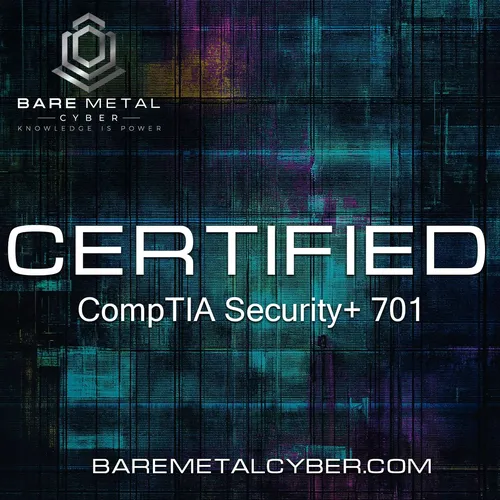
Certified: The Security+ Prepcast
Certify – Security+ 701 is your complete audio companion for mastering the CompTIA Security+ SY0-701 certification exam. Designed for aspiring cybersecurity professionals, this narrated series breaks down every domain of the official exam objectives with clarity, focus, and real-world context. Whether you’re commuting, exercising, or studying at home, each episode delivers concise, engaging, and exam-relevant content to help you pass with confidence.
Created by cybersecurity author and educator Dr. Jason Edwards, this podcast is designed for learners who seek practical explanations, effective study strategies, and a structured path to certification. If you're serious about passing the Security+ exam—and launching your cybersecurity career—this podcast is your edge.
For a deeper study experience, grab a copy of Achieve CompTIA Security+ SY0-701 Exam Success by Dr. Jason Edwards. It’s the most concise and comprehensive Security+ guide available—built for busy professionals who want to pass the exam quickly and on their first attempt. You’ll also find additional resources, practice questions, and tools at BareMetalCyber.com.
- Update frequency
- every day
- Average duration
- 19 minutes
- Episodes
- 221
- Years Active
- 2025

Episode 181: Incident Response Policies and Procedures (Domain 5)
An effective incident response program starts with well-defined policies and procedures that guide every action, role, and escalation during a security event. In this episode, we explore the componen…

Episode 180: Key Security Policies and Standards (Domain 5)
Policies and standards are the written expression of an organization’s security expectations—and in this episode, we explore how they’re developed, communicated, and enforced. We cover essential poli…

Episode 179: Introduction to Security Governance (Domain 5)
Security governance is the blueprint for how an organization manages its security strategy, aligns it with business goals, and ensures accountability across all levels of operation. In this episode, …

Episode 178: Introduction to Domain Five — Security Program Management and Oversight
Cybersecurity isn’t just about blocking attacks and managing firewalls. It’s also about building policies, assessing risk, managing vendors, and aligning security with the overall goals of the busine…

Episode 177: Packet Captures in Investigations (Domain 4)
Packet captures are the most detailed and revealing form of network data available to defenders—showing not just what happened, but exactly how it happened, byte by byte. In this episode, we explain …

Episode 176: Dashboards and Visualization Tools (Domain 4)
A well-designed dashboard can turn complex security data into fast, actionable insight—and in this episode, we explore how visualization tools help analysts, engineers, and executives understand the …

Episode 175: Vulnerability Scan Data and Automated Reporting (Domain 4)
Vulnerability scan data is only useful when it’s collected, organized, and presented in a way that drives action—and this episode explains how automated reporting transforms raw scan results into ope…

Episode 174: Leveraging Log Data (Part 2) (Domain 4)
In this continuation of our log analysis discussion, we shift from collection to interpretation—examining how different data sources support threat detection, forensic investigation, and compliance r…

Episode 173: Leveraging Log Data (Part 1) (Domain 4)
Logs are the record books of your infrastructure, capturing who did what, when, and where—and in this episode, we explore how to extract value from them. We start with common log types including fire…

Episode 172: Forensic Evidence Preservation and E-Discovery (Domain 4)
Once digital evidence is collected, preserving it and producing it responsibly are the next critical steps—and in this episode, we focus on maintaining evidentiary integrity through preservation and …

Episode 171: Forensics – Data Acquisition and Reporting (Domain 4)
Capturing and reporting digital evidence is a delicate process that must be repeatable, verifiable, and legally defensible. In this episode, we focus on how to perform data acquisition properly—wheth…

Episode 170: Digital Forensics Foundations (Domain 4)
When a security incident occurs, understanding what happened—and proving it—requires digital forensics. In this episode, we cover foundational concepts of digital forensics, including data acquisitio…

Episode 169: Root Cause Analysis and Threat Hunting (Domain 4)
Stopping an incident isn’t enough—you have to understand how it happened and whether something deeper is still lurking. This episode explores root cause analysis and threat hunting as advanced invest…

Episode 168: Incident Response Training and Testing (Domain 4)
A well-written incident response plan is only useful if your team knows how to execute it—and the best way to build that confidence is through training and testing. In this episode, we explore variou…

Episode 167: Incident Response – Lessons Learned (Domain 4)
Every incident is a learning opportunity, and the final step of the response lifecycle—lessons learned—ensures that your team emerges stronger, smarter, and better prepared. In this episode, we explo…

Episode 166: Incident Response Process (Part 2) (Domain 4)
Following detection and analysis, the next phases in an incident response plan are containment, eradication, and recovery—critical steps that stop the spread of an attack and restore operations. Cont…

Episode 165: Incident Response Process (Part 1) (Domain 4)
A strong incident response process can mean the difference between a contained event and a catastrophic breach—and in this episode, we break down the first half of the response lifecycle: preparation…

Episode 164: Considerations for Security Automation (Part 2) (Domain 4)
Continuing our discussion on automation pitfalls, this episode focuses on the risk of single points of failure, technical debt, and long-term support challenges. Centralized automation platforms can …

Episode 163: Considerations for Security Automation (Part 1) (Domain 4)
As powerful as automation is, it’s not without challenges—and in this episode, we dive into the complexity and cost considerations that come with security automation projects. Poorly scoped automatio…

Episode 162: Benefits of Security Automation (Part 2) (Domain 4)
Building on the first part of our automation series, this episode explores how security automation improves scalability, incident reaction time, and team productivity. We examine real-world examples …